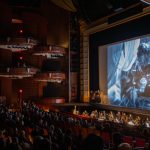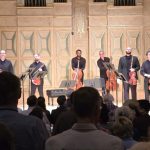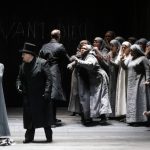November 14 and 15, 2025
Meymandi Concert Hall
Raleigh, North Carolina — USA
North Carolina Symphony; Carlos Miguel Prieto, conductor; Paul Watkins, violoncello.
Jennifer HIGDON, Suite from Cold Mountain (2022)
Robert SCHUMANN, Cello Concerto in A Minor, op. 129 (1850)
Ludwig van BEETHOVEN, Symphony No. 3 in E-flat Major “Eroica” (1804)
Christopher Hill | 17 NOV 2025
Along with the remarkable nonagenarian John Williams, Jennifer Higdon’s name heads many lists of the best living U.S. composers. When she started composing her first opera, Cold Mountain (based on Charles Frazier’s well-known novel), she was turning 50 and had recently won a Pulitzer Prize for her Violin Concerto. Already a mature and prolific composer, she plunged boldly into writing an Appalachian piece, a genre many composers considered to be “owned” by Aaron Copland, if only because no one wanted their work to be unfavorably compared to Copland’s popular masterpieces. Higdon’s Appalachian music definitely sounds Appalachian, but it also sounds nothing like Copland. Rather, it sounds like Higdon, whose identifiable musical persona is the main reason she tops those lists.
Nonetheless, the composer may have found the thought of writing a successful opera daunting. In any event, she worked on the opera over a period of two-plus years—no Donizetti, she. Cold Mountain was first produced at the prestigious Santa Fe Opera (where your reviewer once saw Stravinsky attending a production of Ravel). Santa Fe created the opera with six sold-out performances in 2015. The next year in London, at the International Opera Awards, Cold Mountain was declared the best world premiere anywhere in 2015. A recording of it was nominated for two Grammys.
End of story? No. In 2022, Higdon disassembled the music and reordered and linked selected sections to create a Suite with its own musical logic. In performance, the opera lasts about two and a half hours; the Suite is about eighteen minutes long. Performances of the Suite from Cold Mountain are accessible on YouTube, but some are so different from how the North Carolina Symphony played the piece as to seem like different works. On Friday evening, the many different moods of the Suite were teased out expertly, played with conviction, and presented as a single movement that combines variety with internal coherence. This is an orchestral piece that could become an American standard. Maybe not quite like Bernstein’s West Side Story dance suite or Copland’s ballets, both of which make excitement paramount. The energy in Higdon’s Suite from Cold Mountain is overall more inward, less aggressive, even if the framing paragraphs of the Suite are highly energetic and dramatic. In Raleigh, the audience response to the music on Friday demonstrated an appetite for approachable music that expresses feeling through song rather than just dance. So I’ll say it again: This is a work that could become a standard.

Composer Jennifer Higdon takes a bow following the NC Symphony’s performance of the ‘Suite from Cold Mountain.’ (courtesy of North Carolina Symphony)
Higdon was present at both the rehearsals and the performance, and at the performance she took a bow to thunderous applause. She also joined conductor Carlos Miguel Prieto in a pre-concert talk about her Suite, during which attendees learned that the farm she grew up on was so close to Cold Mountain that it can be located on a map appearing in the novel.
Jennifer Higdon’s Suite from Cold Mountain was commissioned by a consortium of 34 orchestras (one source claims 37). Robert Schumann’s Cello Concerto in A Minor was commissioned by no one. And it was played by no one during the composer’s lifetime. Schumann just wanted to write a cello concerto. One of Schumann’s last musical projects was creating a rehearsal score of the Cello Concerto, and even though the composer had never heard the work played, he made revisions to slurring and other practical aspects of the solo part in that rehearsal score, which was published. Nineteenth-century musicians still didn’t want to play the concerto. The work (particularly its last movement) is technically difficult but not technically gratifying. The cellist’s fingers are forced almost to stumble over each other executing chromatic motives in the instrument’s upper A-string tessitura, motives that might seem child’s play on a woodwind instrument or just moderately difficult on a fiddle. But don’t suppose Schumann didn’t know what he was doing: he was an amateur cellist himself. It’s just that he also was a servant of his potent musical muse, and if the music that flowed from his musical muse included hard-to-play figurations, Schumann accepted this. He always had, no less in his much-played early piano works than in his later works featuring winds and strings.
The concerto was eventually premiered in 1860 as part of a Leipzig concert commemorating the fiftieth anniversary of Schumann’s birth. Over the next quarter-century, it received, at most, a handful of performances. Still, there was a nagging problem regarding the concerto: its music is both affective and effective on several levels. Accordingly, after Breitkopf und Haertel began publication of a prestigious Schumann edition in 1882, and after interest in Schumann’s music seems to have concomitantly risen, during the last fifteen years of the nineteenth century, Schumann’s music attracted two cellists who, from time to time, were able to advocate for this musically rich piece. Then, during the first half of the twentieth century, the high artistry and sustained advocacy of Pablo Casals brought Schumann’s concerto from relative obscurity into the canon of oft-played works. There it remains today.
In Raleigh this weekend, the concerto was played by Paul Watkins, a Welsh cellist, conductor, and administrator of distinction. Watkins has been a cellist in two world-class chamber groups, The Nash Ensemble and the Emerson String Quartet. Since the Emerson Quartet’s retirement in 2023, he has soloed with major international orchestras, conducted major regional orchestras in the U.S. and Great Britain, taught a studio of graduate-level cellists at Yale University, and continued as an effective artistic director of the Chamber Music Festival in Detroit. He seems to your reviewer even more of a Renaissance Man than William Schuman.
On the dais in performance, Watkins proved to be a splendid champion for Schumann. His instrument dates from early eighteenth-century Venice, and, boy, does Watkins know how to make all four strings of that old tub sing, sing sweetly and sing nobly, even when they’re being attacked with masculine vigor. Singing and masculine vigor are essential elements of this Schumann concerto.
So is the gentle elasticity of tempo that Watkins employed. To play this music without that elasticity is to deny its deep humanity. On the other hand, to play the music with unbridled rubato (as that Rodin among cellists, Rostropovich, did) is to place so much emphasis on the musical surface that the internal balance of the musical structure becomes obscure. And Schumann (unlike Schubert) was one of the most interesting explorers of structure in the nineteenth century. In short, your reviewer finds Watkins’ “middle way” of marrying surface and structure to be well-nigh ideal. And he did it with flair, even if he fudged a couple of blazingly fast low notes and even if he let out a sigh of relief after brilliantly executing the most damningly difficult solo passage of the finale. If there’s an afterlife, and if Schumann is in it, I hope he heard Watkins’ heartfelt performance on Friday evening. It would make the composer proud.
Turning briefly to the orchestra players and their conductor: Watkins could not have achieved what he did without a highly collaborative and nuanced accompaniment. And that’s what the players provided, a chamber-music-like attention to ebb and flow. The credit is clearly theirs, but the impetus to perform with such alert sensitivity is just as clearly Prieto’s.
As an encore, Watkins played the “Sarabande” from a Bach’s Suite in C Major for solo cello.

Paul Watkins performs the “Sarabande” from Bach’s ‘Cello Suite in C Major’ as an encore. (courtesy of North Carolina Symphony)
After intermission, the orchestra tackled one of the most iconic works in the symphonic literature, Beethoven’s Symphony No. 3 in E-flat Major (“Eroica”). It’s virtually impossible to talk about this symphony without resorting to clichés. Some clichés, however, seem unavoidable—for example, the question: How can a work that has been played tens of thousands of times still retain the power to astonish? Another: How can a work that has been played tens of thousands of times keep pulling in very large audiences, including, in Raleigh, a healthy proportion of twenty- and thirty-year-olds? The answer to both questions lies at the very core of what recreative music is about. It isn’t the notes alone; it’s what people do with them. And when what people do with the notes happens not virtually but in real time and space (the way Beethoven intended), it existentially multiplies the impact of the experience. It’s how humans are wired.
So what did the North Carolina Symphony and its conductor do with Beethoven’s notes? First, they played like angels. They played as if every phrase were an essential part of the huge message this symphony conveys. You could hear those phrases as they unfolded in every section, despite the fact that Meymandi is a reverberant hall, even when it’s packed. When scoring is thick, as it sometimes is in Beethoven, the hall tends to blur sounds, especially in the lower strings. Somehow Prieto, with this modern orchestra, manages to open up the hall’s acoustic space in piece after piece, through delicate adjustments to orchestral balances.
These adjustments require a lot of focus on the part of the players, and the North Carolina players provide it, even as their conductor, Prieto, with his vivid podium technique, urges them also to play with total emotional immersion. In response, the players present a human-scaled version of what the conductor both asks for and demonstrates—that is, not “total emotional immersion” but something that aspires and at times veers close to it. Which is perfect for Beethoven, because the power of his Eroica lies in the strength and nobility and large inner world he finds in human-scaled (as opposed to top-down, dictatorial) things.
When a healthy relationship obtains between a conductor and an orchestra, the conductor, during performances, clearly functions as the orchestra’s navigator and also as its memory bank for what occurred in rehearsals. That happened Friday evening in Raleigh, and my confidence in claiming this is based on what happened during the performance of the Eroica’s first movement. At the beginning, during the exposition, when the woodwinds played as a choir, they were still playing Schumann.
Here’s what I mean. Schumann’s scoring in the Cello Concerto emphasizes static contrasts of timbre between choirs of strings, choirs of winds, and choirs of brass. It’s sort of like a painter’s palette where the different colors remain purely themselves and have not yet been mixed. In Beethoven’s Eroica, to the contrary, different timbral groups typically talk to each other, weaving a shared message. And this requires every phrase in Beethoven to be played conversationally, as if it is being sung or spoken, even when solo lines are not involved.
In Friday’s performance, during the Eroica’s exposition, woodwind choirs entered as though their contrasting timbre should be heard purely as contrasting, as they were playing in Schumann. This happened a number of times during the exposition. But then, probably through the player’s interaction with their navigator and memory bank on the podium, during the Eroica’s development, they started playing Beethoven’s way instead of Schumann’s, and they continued doing so for the rest of the symphony.
The previous two paragraphs contain a lot of (perhaps) arcane and tedious detail, but they serve to demonstrate the sustained level of close involvement required for an outstanding performance of the Eroica Symphony. Decades back, during the Bernstein era, your reviewer witnessed the New York Philharmonic rehearsing Beethoven’s Fifth, last movement, during which rehearsal the trombones missed their biggest cue because they were still playing cards. I guarantee you that the Eroica Raleigh heard in Raleigh Friday evening was not prepared this way, and thus it communicated on a different (and much higher) level.
Every conductor has, willy-nilly, their own style. Some excel at precision and top-down discipline, some at plumbing the inner workings of a heavy heart, some at drawing out strong positive emotions (such as fortitude, gratitude, determination, and compassion) connected with each individual’s connections to the rest of the world. Prieto is a fine example of the last kind. Accordingly, the strengths of his Beethoven are shown to best advantage in passages that express nobility (here sounding genuine and unforced), in passages where tension is released (again and again in this symphony, and in this performance always with a sense of warm-heartedness), and also, when building tension, in passages conveying an intensity of commitment that may rightly be termed “heroic.”
Prieto is a busy guest conductor these days, whether it be abroad in London, Strasbourg, Frankfurt, or even Auckland, or on his home continent with orchestras in Atlanta, Chicago, Cleveland, Dallas, Houston, Toronto, Washington D.C., and so on. Keep an eye out for this guy; he may be coming to visit a symphony near you. Here in North Carolina, we get him at regular intervals throughout the year. I’ve said it before, but I’ll say it again: We’re lucky that he has signed up for another five seasons. ■
EXTERNAL LINKS:
- North Carolina Symphony: ncsymphony.org
- Carlos Miguel Prieto: carlosmiguelprieto.com
- Paul Watkins: paulwatkinsmusic.com/a>

Read more by Christopher Hill.







.png)